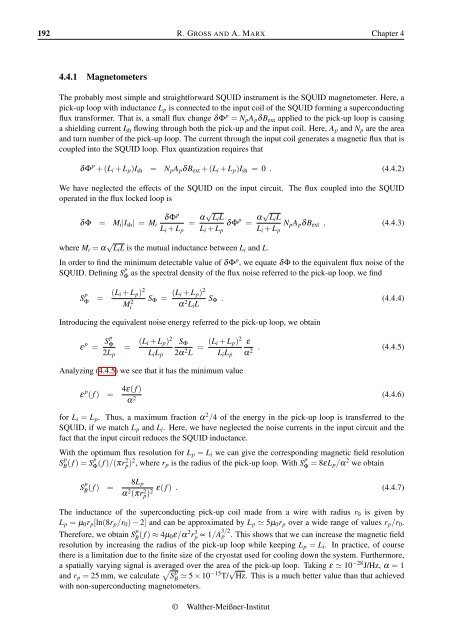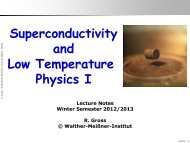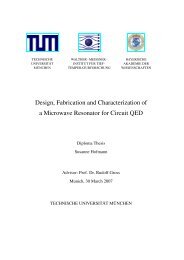Applied Superconductivity - Walther Meißner Institut - Bayerische ...
Applied Superconductivity - Walther Meißner Institut - Bayerische ...
Applied Superconductivity - Walther Meißner Institut - Bayerische ...
- No tags were found...
You also want an ePaper? Increase the reach of your titles
YUMPU automatically turns print PDFs into web optimized ePapers that Google loves.
192 R. GROSS AND A. MARX Chapter 44.4.1 MagnetometersThe probably most simple and straightforward SQUID instrument is the SQUID magnetometer. Here, apick-up loop with inductance L p is connected to the input coil of the SQUID forming a superconductingflux transformer. That is, a small flux change δΦ p = N p A p δB ext applied to the pick-up loop is causinga shielding current I sh flowing through both the pick-up and the input coil. Here, A p and N p are the areaand turn number of the pick-up loop. The current through the input coil generates a magnetic flux that iscoupled into the SQUID loop. Flux quantization requires thatδΦ p + (L i + L p )I sh = N p A p δB ext + (L i + L p )I sh = 0 . (4.4.2)We have neglected the effects of the SQUID on the input circuit. The flux coupled into the SQUIDoperated in the flux locked loop isδΦ = M i |I sh | = M iδΦ pL i + L p= α√ L i LL i + L pδΦ p = α√ L i LL i + L pN p A p δB ext , (4.4.3)where M i = α √ L i L is the mutual inductance between L i and L.In order to find the minimum detectable value of δΦ p , we equate δΦ to the equivalent flux noise of theSQUID. Defining S p Φas the spectral density of the flux noise referred to the pick-up loop, we findS p Φ = (L i + L p ) 2M 2 iS Φ = (L i + L p ) 2α 2 L i LS Φ . (4.4.4)Introducing the equivalent noise energy referred to the pick-up loop, we obtainε p =Sp Φ= (L i + L p ) 22L p L i L pS Φ2α 2 L = (L i + L p ) 2L i L pεα 2 . (4.4.5)Analyzing (4.4.5) we see that it has the minimum valueε p ( f ) = 4ε( f )α 2 (4.4.6)for L i = L p . Thus, a maximum fraction α 2 /4 of the energy in the pick-up loop is transferred to theSQUID, if we match L p and L i . Here, we have neglected the noise currents in the input circuit and thefact that the input circuit reduces the SQUID inductance.With the optimum flux resolution for L p = L i we can give the corresponding magnetic field resolutionS p B ( f ) = Sp Φ ( f )/(πr2 p) 2 , where r p is the radius of the pick-up loop. With S p Φ = 8εL p/α 2 we obtainS p B ( f ) = 8L pα 2 (πr 2 ε( f ) . (4.4.7)2p)The inductance of the superconducting pick-up coil made from a wire with radius r 0 is given byL p = µ 0 r p [ln(8r p /r 0 ) − 2] and can be approximated by L p ≃ 5µ 0 r p over a wide range of values r p /r 0 .Therefore, we obtain S p B ( f ) ≈ 4µ 0ε/α 2 r 3 p ∝ 1/A 3/2p . This shows that we can increase the magnetic fieldresolution by increasing the radius of the pick-up loop while keeping L p = L i . In practice, of coursethere is a limitation due to the finite size of the cryostat used for cooling down the system. Furthermore,a spatially varying signal is averaged over the area of the pick-up loop. Taking ε ≃ 10 −28 J/Hz, α = 1and r p = 25 mm, we calculate √ S p B ≃ 5 × 10−15 T/ √ Hz. This is a much better value than that achievedwith non-superconducting magnetometers.© <strong>Walther</strong>-Meißner-<strong>Institut</strong>
















